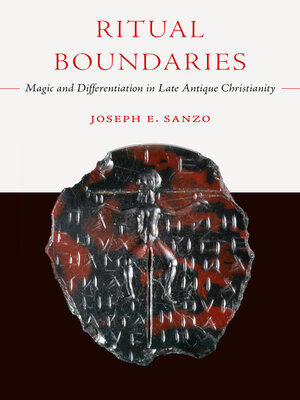Ritual Boundaries
ebook ∣ Magic and Differentiation in Late Antique Christianity · Christianity in Late Antiquity
By Joseph E. Sanzo

Sign up to save your library
With an OverDrive account, you can save your favorite libraries for at-a-glance information about availability. Find out more about OverDrive accounts.
Find this title in Libby, the library reading app by OverDrive.



Search for a digital library with this title
Title found at these libraries:
| Library Name | Distance |
|---|---|
| Loading... |
A free ebook version of this title is available through Luminos, University of California Press's Open Access publishing program. Visit www.luminosoa.org to learn more.
In Ritual Boundaries, Joseph E. Sanzo transforms our understanding of how early Christians experienced religion in lived practice through the study of magical objects, such as amulets and grimoires. Against the prevailing view of late antiquity as a time when only so-called elites were interested in religious and ritual differentiation, the evidence presented here reveals that the desire to distinguish between religious and ritual insiders and outsiders cut across diverse social strata. The magical evidence also offers unique insight into early biblical reception, exposing a textual world in which scriptural reading was multisensory and multitraditional. As they addressed sickness, demonic struggle, and interpersonal conflicts, Mediterranean people thus acted in ways that challenge our conceptual boundaries between Christians and non-Christians; elites and non-elites; and words, materials, and images. Sanzo helps us rethink how early Christians imagined similarity and difference among texts, traditions, groups, and rituals as they went about their daily lives.
In Ritual Boundaries, Joseph E. Sanzo transforms our understanding of how early Christians experienced religion in lived practice through the study of magical objects, such as amulets and grimoires. Against the prevailing view of late antiquity as a time when only so-called elites were interested in religious and ritual differentiation, the evidence presented here reveals that the desire to distinguish between religious and ritual insiders and outsiders cut across diverse social strata. The magical evidence also offers unique insight into early biblical reception, exposing a textual world in which scriptural reading was multisensory and multitraditional. As they addressed sickness, demonic struggle, and interpersonal conflicts, Mediterranean people thus acted in ways that challenge our conceptual boundaries between Christians and non-Christians; elites and non-elites; and words, materials, and images. Sanzo helps us rethink how early Christians imagined similarity and difference among texts, traditions, groups, and rituals as they went about their daily lives.







